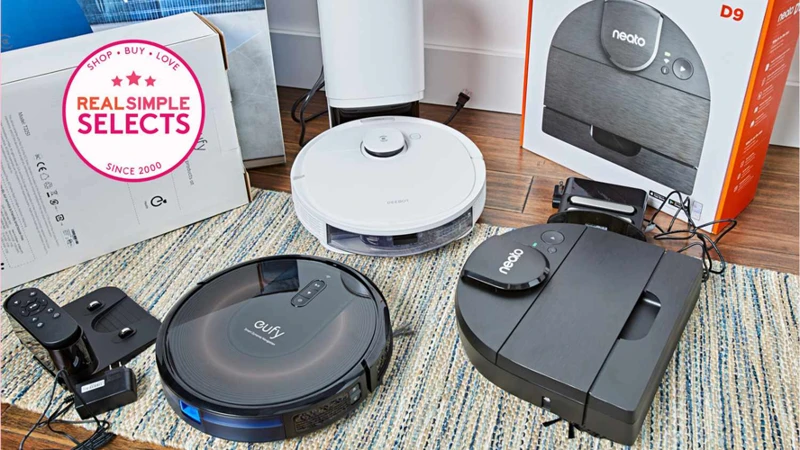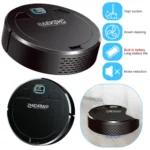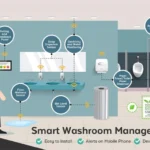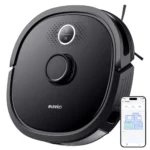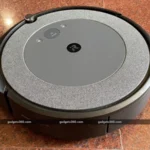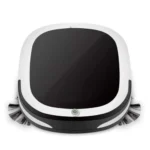As our homes become smarter and more connected with the Internet of Things (IoT), household chores are also receiving a major upgrade. One area that has seen a significant improvement is cleaning with the emergence of smart vacuum cleaners. These high-tech devices are equipped with advanced features, including Wi-Fi connectivity, that make cleaning a breeze. However, how does Wi-Fi connectivity specifically impact the performance of these devices? In this article, we will explore the advantages of Wi-Fi connectivity for smart vacuum cleaners and how they contribute to better cleaning performance, as well as factors to consider when purchasing one.
What is a Smart Vacuum Cleaner?
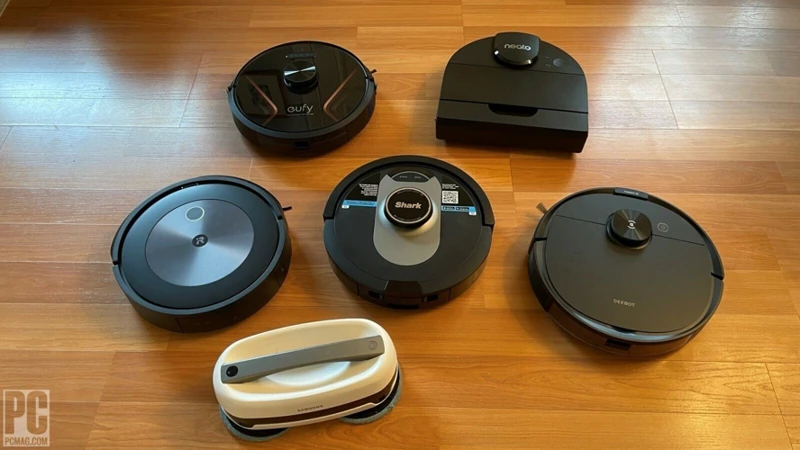
The world is rapidly shifting towards smart home technology and innovative household appliances, with the smart vacuum cleaner being a major player in this arena. Utilizing advanced robotics and artificial intelligence, these devices have become a crucial component of modern cleaning systems. Smart vacuum cleaners are equipped with state-of-the-art features such as Wi-Fi connectivity, mobile app control and mapping technology, and compatibility with smart home systems. With so many options available, it can be difficult to choose the right one. In this section, we’ll delve deeper into what a smart vacuum cleaner is and explore some of the different factors to consider when choosing the best one for your needs. For a list of the top 10 smart vacuum cleaners with Wi-Fi, check out our article on the subject.
The Evolution of Vacuum Cleaners
The evolution of vacuum cleaners is a fascinating topic to explore as it showcases the significant strides made in technology that have led to the development of smart vacuum cleaners like those with Wi-Fi connectivity. Here’s a table highlighting the key stages of vacuum cleaner evolution:
| Stage | Description |
|---|---|
| Manual labor | In the early days, households used a carpet sweeper which was a broom-like device to clean floors partially. Later, a manually operated vacuum cleaner emerged with a hand-operated bellows system that would create suction to pick up dirt and debris. |
| Electric motors | In 1901, a British inventor, Hubert Cecil Booth, developed the first powered vacuum cleaner by fitting an electric motor to a horse-drawn carriage. In 1907, James Murray Spangler developed the first portable electric vacuum cleaner, known as the ‘Model O’. |
| Bagged vacuums | In 1920, William Hoover, an American inventor, developed the first ‘beater bar’ and bagged vacuum cleaner. The bagged model became a popular household item in the 1950s and 1960s. |
| Bagless vacuums | In 1978, James Dyson, a British inventor, came up with the first bagless vacuum cleaner after years of experiments. |
| Robotic vacuums | In 1996, the first robotic vacuum cleaner, the Trilobite, was introduced in Sweden by Electrolux. Later in 2002, iRobot introduced the Roomba – the first robotic vacuum to become a commercial success. |
| Smart vacuums with Wi-Fi connectivity | Modern-day smart vacuum cleaners combine robotic technology with Wi-Fi connectivity to offer unparalleled convenience and efficiency. These smart vacuums can map and navigate the floor plan of the home, providing better cleaning performance than their predecessors. They can also be controlled via a smartphone app, and some models can integrate with popular smart home systems. |
It’s evident from the table that we’ve come a long way from manually operated cleaning tools to smart vacuums with Wi-Fi connectivity. If you’re interested in learning more about the benefits and downsides of Wi-Fi connected smart vacuums, check out this article.
The Smart Vacuum Cleaner
The smart vacuum cleaner is the latest technological innovation in the world of vacuum cleaners. It has brought a significant shift in the way people clean their homes. With the advancement of technology, smart vacuums have become more than just a cleaning tool. They are now intelligent gadgets that learn about your home and clean up without any human intervention.
Smart sensors: Unlike traditional vacuum cleaners, smart vacuums come equipped with multiple sensors that detect dirt, dust, and debris. These sensors help the vacuum to navigate around furniture and other obstacles present in the room while cleaning the floor. The sensors alert the vacuum to change its direction when it encounters any object or obstacle in its path.
Auto-recharge: Smart vacuums can recharge themselves automatically. When the battery is about to run out, they automatically return to their docking station and recharge, ensuring they are ready for the next cleaning cycle.
Programmable cleaning: Smart vacuums come with a programmable cleaning feature. This allows you to schedule the vacuum to clean at certain times of the day, which means you do not have to worry about setting it up manually every time.
Wi-Fi connectivity: One of the most significant features of smart vacuums is their Wi-Fi connectivity. This feature allows owners to control the vacuum from their smartphone or tablet from anywhere at any time. Also, it allows the users to customize the cleaning schedule, and some models let you customize the suction power for thorough cleaning.
Mapping technology: Some smart vacuums can create a map of your home while cleaning. The mapping technology enables the vacuum to remember your home’s layout and create a cleaning plan. This helps to ensure that every part of your home is cleaned efficiently.
Smart home integration: Another essential feature is the smart home integration. Most smart vacuums can connect with other smart devices in your home, such as Google Home or Amazon Alexa. You can control the vacuum using voice commands, making it more convenient to use.
Suction power: Suction power is one of the most significant factors that determine how well a vacuum cleans. Smart vacuums have different suction powers, and the higher the suction power, the better the cleaning. Additionally, the type of filter system used also determines how well the vacuum can clean.
Smart vacuums have brought a significant change in how people approach cleaning their homes. With their advanced features and Wi-Fi connectivity, they are becoming more popular than traditional vacuum cleaners. If you want to know more about the best Wi-Fi connected smart vacuums in the market, check out the best smart vacuum with Wi-Fi blog.
How Does Wi-Fi Connectivity Work for Smart Vacuum Cleaners?
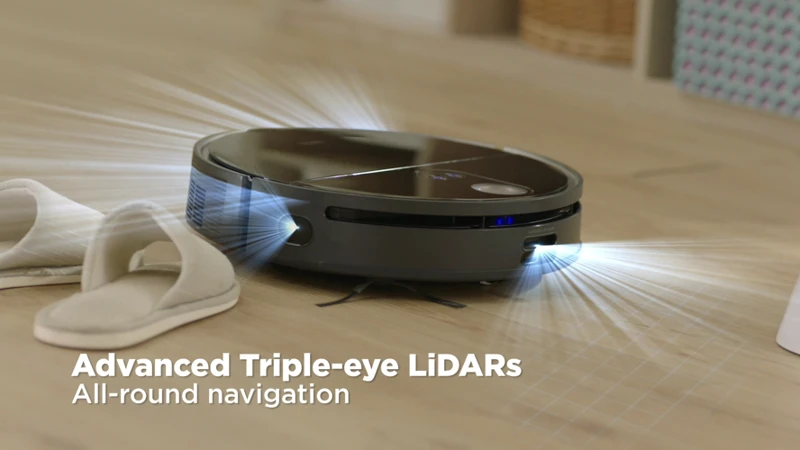
In today’s era of technology, smart vacuum cleaners with Wi-Fi connectivity have become a popular household gadget. With the ability to clean floors autonomously, these high-tech devices have made life easier for many. But how exactly does Wi-Fi connectivity work for smart vacuum cleaners, and what are the advantages of having this feature? In this article, we’ll explore the ins and outs of Wi-Fi connected smart vacuums, their key features, and how they can contribute to better cleaning performance. We’ll also discuss factors to consider when choosing a Wi-Fi connected smart vacuum cleaner, and provide a relevant comparison between popular Wi-Fi smart vacuums, such as iRobot Roomba, Shark IQ, and Eufy Robovac. So, if you are perplexed about how Wi-Fi connectivity works for smart vacuum cleaners and whether it’s worth the hype, keep reading!
Advantages of Wi-Fi Connectivity
One of the advantages of Wi-Fi connectivity for smart vacuum cleaners is the ability to control and monitor the device remotely through a dedicated mobile app or voice assistant. This means that users can start and stop the vacuum, schedule cleaning sessions, and customize the cleaning settings from anywhere, at any time.
Another benefit of Wi-Fi connectivity is the automatic software updates that keep the vacuum cleaner up-to-date with the latest features and improvements. With regular firmware updates, users can enjoy better cleaning performance, bug fixes and new functions without having to buy a new device.
Wi-Fi connected smart vacuums can also provide enhanced cleaning experiences. With a machine-learning algorithm, for example, a vacuum can automatically learn and adjust to the user’s cleaning habits over time, ensuring better coverage and cleaning efficiency.
Some Wi-Fi connected vacuum cleaners come with smart mapping technology, which allows them to navigate their environment and create a precise map of the home, identifying which areas have already been cleaned and which ones still need to be. This feature ensures that the vacuum covers every inch of the house for optimal cleaning.
Finally, Wi-Fi connectivity has also opened up the possibility for smart home integration with voice control, enabling users to seamlessly integrate their smart vacuum cleaner with other smart home devices. Users can, for instance, ask Alexa or Google Assistant to start the vacuum cleaning process, or they can set up custom routines that include their vacuum cleaner, such as “Alexa, clean the living room every Monday at 10 am.”
If you want to learn about the most popular Wi-Fi smart vacuum cleaners on the market, read this comparison. Alternatively, if you are struggling with Wi-Fi connectivity issues, you can read our guide on how to troubleshoot these problems.
Key Features of Wi-Fi Connected Smart Vacuums
Modern technology has paved the way for Smart Vacuum Cleaners, revolutionizing the way we clean our homes. Wi-Fi Connectivity has added another dimension to the capabilities of these robotic cleaners, providing a range of features that enhances their performance. Here are some Key Features of Wi-Fi Connected Smart Vacuums:
| Feature | Benefit |
|---|---|
| Mobile App Control | Allows you to remotely control and schedule cleaning cycles from your smartphone, enabling you to manage cleaning even when you’re not at home. |
| Virtual Mapping | Creates a real-time virtual map of your home, allowing the robot to navigate more efficiently and avoid obstacles. |
| Voice Control | Enables you to control the robot using voice commands via Amazon Alexa or Google Assistant for hands-free cleaning. |
| Smart Home Integration | Enables integration with other smart devices such as smart speakers, thermostats, and security systems, creating a seamless smart home ecosystem. |
| Auto-Recharge and Resume | Sends the robot back to its charging station automatically when the battery runs low and then resumes cleaning once fully charged. |
| HEPA Filters | Captures microscopic particles and allergens, making it perfect for households with pets and allergy sufferers. |
| Multi-Surface Cleaning | Adapts to different types of flooring and adjusts its suction power accordingly, ensuring maximum cleaning performance on all surfaces. |
With these features, a Wi-Fi connected Smart Vacuum Cleaner provides an efficient and convenient cleaning experience for homeowners. The ability to control these robots remotely, create virtual maps of the home, and integrate with other smart devices, adds greater utility to the cleaning process. For more information on the various features of Wi-Fi Connected Smart Vacuums, you can check out our article on Wi-Fi Smart Vacuum Mapping Comparison and Smart Home Integration with Smart Vacuums.
The Benefits of Wi-Fi Connectivity on Smart Vacuum Cleaner Performance
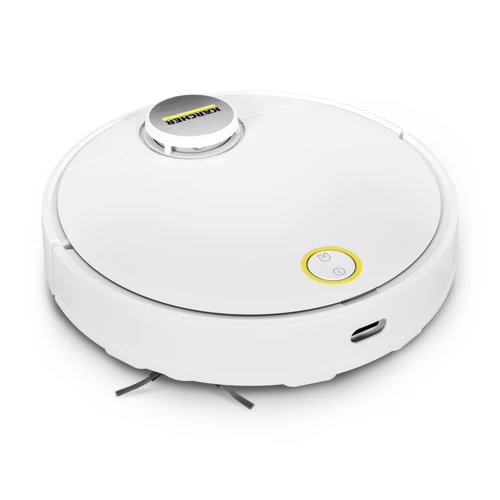
As technology continues to advance and make our lives easier, smart home appliances have been gaining popularity in recent years. Among these innovative devices are smart vacuum cleaners, which have made the tedious task of cleaning floors a breeze. But with the addition of Wi-Fi connectivity, these vacuums have become even more convenient and efficient. In this section, we will explore the various benefits of having a Wi-Fi connected smart vacuum cleaner, which include improved convenience, better control and monitoring, and enhanced cleaning performance. Plus, we will provide insight into factors to consider when choosing a Wi-Fi connected vacuum cleaner to ensure that you invest in the best option for your home. If you’re wondering whether smart vacuum app control is worth the hype, keep reading!
Improved Convenience and Efficiency
The integration of Wi-Fi connectivity in smart vacuum cleaners has greatly improved the convenience and efficiency of cleaning tasks. Here are some ways Wi-Fi connectivity has contributed to these improvements:
- Remote Control: With Wi-Fi connectivity, you can control your smart vacuum cleaner remotely from your smartphone or another device. This means you can start, pause or stop cleaning without physically being next to the vacuum cleaner. Imagine how convenient it is to start cleaning your house when you are at work so you can come home to a clean and fresh-smelling house.
- Scheduled Cleaning: Wi-Fi connected smart vacuums have the feature of scheduling cleaning, allowing you to set up specific cleaning times. This means your vacuum cleaner can turn on and clean your house even when you are not there to start it manually. This feature is beneficial for people who have busy schedules and cannot always make time for cleaning.
- Efficient Navigation: Wi-Fi connected smart vacuums come with intelligent navigation software that helps them navigate through your home’s interior space efficiently. With these features, they can move around obstacles and clean under furniture without supervision. This means you can accomplish other tasks while the smart vacuum cleaner is cleaning, saving you time and effort.
- Easy Maintenance: Wi-Fi connected smart vacuums come with convenient maintenance notifications, making it easy to know when to empty the dustbin or replace the filter. This reduces the chances of clogging and helps the vacuum cleaner maintain optimal cleaning performance.
These are just some of the ways Wi-Fi connectivity has improved the convenience and efficiency of a smart vacuum cleaner. With advancements in technology, these features will continue to improve, making cleaning tasks more effortless and less time-consuming.
Better Control and Monitoring
One of the notable advantages of Wi-Fi connectivity on smart vacuum cleaners is the better control and monitoring it provides to the user. With the help of a mobile application or a virtual assistant, users can easily control their smart vacuums from anywhere, anytime.
Control
The control feature allows users to start, pause or stop the cleaning cycle of their smart vacuum cleaner remotely. This means that even if you are not at home, you can still ensure that the cleaning is happening as per your preferences. The schedule feature enables you to set cleaning times for different days of the week, so that you don’t need to worry about your vacuuming routine anymore.
Monitoring
With monitoring feature, you can keep an eye on your smart vacuum’s cleaning status in real-time. The app provides information on the battery level, cleaning progress, and the performance of your vacuum’s filter. You’ll receive notifications when the vacuum requires maintenance or needs to be emptied. Some models even have a mapping feature enabling you to map out the boundaries of the cleaning area.
Here is a table that shows some of the control and monitoring features of Wi-Fi connected smart vacuum cleaners:
| Features | Description |
|---|---|
| Remote Control | You can start, pause, or stop cleaning remotely. |
| Scheduling | You can set a cleaning schedule for any day of the week. |
| Battery Monitoring | You can check the battery level of the vacuum remotely. |
| Cleaning Status | You can monitor the cleaning progress and receive updates in real-time. |
| Notification Alerts | You’ll receive maintenance or filter replacement notifications. |
| Mapping Feature | You can map the cleaning area and create custom cleaning zones. |
The control and monitoring features provided by Wi-Fi connected smart vacuum cleaners offer users a great deal of convenience and control over their cleaning routine. These features take cleaning to a whole new level, making it customizable and hassle-free.
Enhanced Cleaning Performance
When it comes to cleaning, the ultimate goal of a smart vacuum cleaner is to provide a deep and thorough clean on a regular basis with minimal effort from the user. With Wi-Fi connectivity, smart vacuums are able to achieve an even higher level of cleaning performance.
Cleaning Schedules: One of the key benefits of Wi-Fi connectivity is the ability to schedule cleaning sessions. This feature means that users can program their smart vacuum cleaners to clean at specific times, ensuring that their homes are constantly being cleaned. Whether it’s daily, weekly or bi-weekly, users have the control to set up the cleaning schedule as per their convenience.
Customizable Cleaning Modes: Wi-Fi connected smart vacuums come with multiple cleaning modes. These modes have specific purposes and can be implemented based on the type of cleaning that is needed. For example, if someone has pets or allergies, they can select the specific cleaning mode to ensure that the vacuum picks up pet fur or allergens. Some modes include auto-cleaning, spot cleaning, edge cleaning, and more.
Remote Control: With Wi-Fi capability, users are able to control their smart vacuum cleaners from anywhere, at any time via a mobile app. This means that if someone is at work or on vacation, they can start or pause the cleaning session remotely.
Real-time Monitoring: Wi-Fi connected smart vacuums have the ability to provide real-time monitoring. The user can check the cleaning status, battery level, and the power of suction. This real-time monitoring ensures that the device is functioning at optimal performance and that it is able to deliver a high standard of cleaning.
AI-Powered Navigation: Some smart vacuum cleaners have artificial intelligence-powered navigation. This helps the robot understand the floor pattern, estimate the room size and map it. As a result, smart vacuums can not only clean effectively but intelligently too. They know when they need to return to the docking station to recharge, and where they’re at in terms of the cleaning session.
With Wi-Fi connectivity, smart vacuum cleaners become an intelligent tool for cleaning the floors. They are able to provide efficient cleaning with minimal effort from the user, resulting in a cleaner and healthier home environment.
Factors to Consider When Choosing a Wi-Fi Connected Smart Vacuum Cleaner
Choosing the right Wi-Fi connected smart vacuum cleaner can be a daunting task. With so many options available on the market, it can be confusing to determine which one would be the best fit for your needs. However, there are certain key factors that you should keep in mind while making your decision. In this section, we will discuss some of the most important considerations that you should pay attention to before making a purchase. By the end of this article, you should have a clear understanding of what to look for in a Wi-Fi connected smart vacuum cleaner.
Budget
When considering a Wi-Fi connected smart vacuum cleaner, budget plays a crucial role. You can find several models with different features and price tags, so it’s essential to consider how much you’re willing to spend. It’s important to keep in mind that the price of a smart vacuum cleaner can vary based on its features and capabilities.
Table:
| Smart Vacuum Cleaner Model | Price Range |
|---|---|
| iRobot Roomba i7+ | $800-$1,000 |
| Shark IQ Robot Self-Empty XL | $500-$600 |
| Eufy Robovac G30 Edge | $200-$300 |
| iLife V3s Pro | $100-$200 |
The iRobot Roomba i7+ is one of the most expensive models, but it comes with advanced features like self-emptying capabilities and intelligent mapping technology. The Shark IQ Robot Self-Empty XL is another high-end option that is slightly more affordable than the iRobot Roomba i7+, but it still has excellent cleaning capabilities and the ability to empty its dustbin independently.
If you’re on a tighter budget, the Eufy Robovac G30 Edge is an excellent option. It’s reasonably priced and offers features like voice control and specialized cleaning modes. The iLife V3s Pro is the most affordable smart vacuum cleaner on our list, but it doesn’t have Wi-Fi connectivity.
Conclusion:
When choosing a Wi-Fi connected smart vacuum cleaner, it’s essential to determine your budget and what features are essential for your cleaning needs. Consider the price ranges for each model and compare them with their specific features before making a final decision. It’s important to remember that the price of a smart vacuum cleaner doesn’t always dictate its performance, and you can find an excellent model without breaking the bank.
Compatibility with Smart Home Systems
When looking for a Wi-Fi connected smart vacuum cleaner, it’s important to consider its compatibility with your smart home system. Here are some key factors to keep in mind:
- Platform: The first thing you’ll want to check is whether the smart vacuum cleaner is compatible with the platform you use to control your smart home devices. Some popular platforms include Amazon Alexa, Google Home, and Apple HomeKit. Make sure the vacuum cleaner you choose has the necessary integrations to work with your platform.
- Connectivity: In addition to platform compatibility, you’ll want to ensure that the smart vacuum cleaner connects to your home Wi-Fi network in a stable and reliable manner. Look for reviews that specifically mention connectivity issues, and choose a model that has a strong track record in this area.
- Automation: One of the biggest advantages of a smart vacuum cleaner is the ability to automate cleaning tasks. Make sure the vacuum cleaner you choose can be controlled through your smart home system, and that you can set up custom cleaning schedules and routines as needed.
- Integration: Some smart vacuum cleaners offer deeper integration with your smart home system than others. For example, some models can automatically pause cleaning when you receive a phone call, or even integrate with your smart door lock to automatically start cleaning when you leave the house. Consider your specific needs and look for a model that offers the right level of integration.
Choosing a smart vacuum cleaner that is compatible with your smart home system can help streamline your home automation setup and make cleaning tasks even more convenient. Take the time to research your options and choose a model that offers the right features and compatibility for your individual needs.
Filter System and Suction Power
When choosing a Wi-Fi connected smart vacuum cleaner, it’s important to consider the filter system and suction power.
- Filter System: A good filter system is essential for maintaining indoor air quality. HEPA filters are highly recommended for allergy sufferers and those with respiratory issues. These filters can trap 99.97% of all particles down to 0.3 microns, which includes dust, pollen, pet dander, and other allergens. Some smart vacuum cleaners come with washable filters, while others require replacement filters, so it’s crucial to check the type of filter a particular model uses.
- Suction Power: Suction power is a crucial factor that determines a vacuum cleaner’s cleaning performance. Higher suction power typically means better performance in picking up small and large particles alike. However, too much suction power can damage delicate surfaces such as carpets and upholstery, so it’s important to choose a smart vacuum cleaner with adjustable suction power settings. The suction power should be strong enough to pick up dirt and dust, even in hard-to-reach areas such as corners and crevices.
As a general rule of thumb, a smart vacuum cleaner with a good filter system and suction power will make cleaning more effective and efficient. When researching different models, pay attention to the types of filters used, and the suction power settings available. Testimonials and reviews from other customers are also a great way to gauge the effectiveness of a particular model. By choosing the right smart vacuum cleaner with the right filter system and suction power, you can keep your home clean and healthy without having to lift a finger.
Conclusion
After considering the impact of Wi-Fi connectivity on smart vacuum cleaner performance, it is clear that this technology has revolutionized the way we clean our homes. Wi-Fi connected smart vacuums offer superior convenience, efficiency, and control compared to their traditional counterparts. By allowing users to monitor and control their vacuum cleaners from their smartphones or other connected devices, Wi-Fi connectivity makes cleaning less of a hassle.
In addition, Wi-Fi connected smart vacuums also offer enhanced cleaning performance. With features like better mapping and navigation, these cleaners are able to clean more thoroughly and efficiently than traditional vacuums. Smart vacuums are also equipped with sensors that can detect changes in floor surfaces and adjust suction power accordingly, resulting in a more efficient and effective cleaning experience.
When choosing a Wi-Fi connected smart vacuum, consideration should be given to factors such as budget, compatibility with smart home systems, and filter system and suction power. However, with so many options available, finding the right vacuum cleaner for your needs may be overwhelming. It is important to do your research and read reviews before making a purchase.
Overall, it is clear that Wi-Fi connectivity has had a profound impact on the performance of smart vacuum cleaners. With the added convenience, efficiency, and control that Wi-Fi technology provides, homeowners now have access to powerful cleaning tools that can make the task of cleaning much more manageable. If you are in the market for a new vacuum cleaner, consider investing in a Wi-Fi connected smart vacuum cleaner to experience the benefits firsthand.
Frequently Asked Questions
What is the difference between a traditional vacuum cleaner and a smart vacuum cleaner?
A traditional vacuum cleaner requires manual operation, while a smart vacuum cleaner uses advanced technologies to operate on its own.
Does my home need to have Wi-Fi connectivity for a smart vacuum cleaner to work?
Yes, as the name suggests, a smart vacuum cleaner requires Wi-Fi connectivity to function efficiently and connect with your smart home systems.
Can I control my smart vacuum cleaner while I am away from home?
Yes, you can control your smart vacuum cleaner through your smartphone or tablet, even when you are away from home.
What are the most significant advantages of a Wi-Fi connected smart vacuum cleaner?
The most significant advantages of a Wi-Fi connected smart vacuum cleaner are improved convenience and efficiency, better control and monitoring, and enhanced cleaning performance.
Are all smart vacuum cleaners compatible with all smart home systems?
No, not all smart vacuum cleaners are compatible with all smart home systems. It’s important to check compatibility before making a purchase.
What is the typical lifespan of a smart vacuum cleaner?
The lifespan of a smart vacuum cleaner depends on various factors, such as usage and maintenance, but the average lifespan is around 3 to 5 years.
Do smart vacuum cleaners require professional installation?
No, smart vacuum cleaners do not require professional installation. They are easy to setup and come with instructions to guide the process.
What is the average price range of a Wi-Fi connected smart vacuum cleaner?
Wi-Fi connected smart vacuum cleaners typically range in price from $200 to $800, depending on the model and brand.
Do I need to purchase extra accessories for my smart vacuum cleaner to work optimally?
No, you don’t need to purchase extra accessories for the smart vacuum cleaner to work optimally. However, accessories like additional filters and brushes can enhance the performance of the vacuum.
What is the warranty period for a smart vacuum cleaner?
The warranty period for a smart vacuum cleaner varies by brand and model, but most smart vacuum cleaners come with a warranty period of 1 to 2 years.
